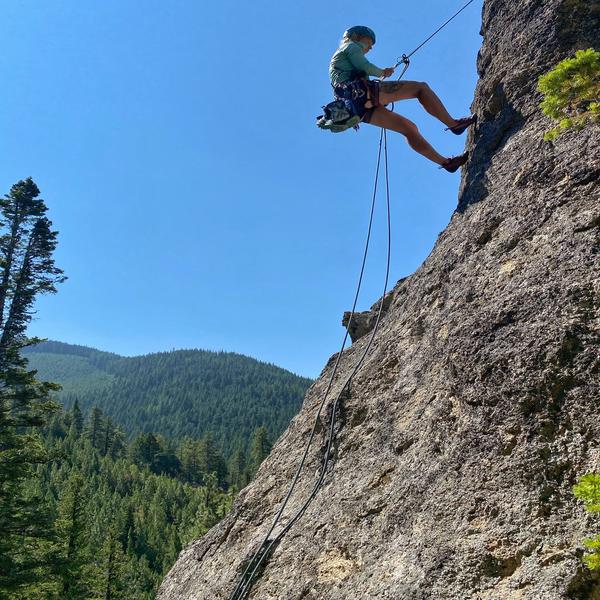
What kind of climbing do you do most?
The first step in choosing the right climbing shoe is to consider the type of climbing you'll be doing most often. Climbing shoes are designed with specific features that cater to different climbing styles:
Bouldering
For bouldering, where precision and grip are crucial, consider a shoe with a downturned shape and a softer midsole. Downturned shoes allow you to pull with your toes, keeping your hips close to the wall for more power and reach. Softer shoes are more sensitive, allowing you to feel the holds, and smear better on less defined edges.
Sport Climbing
Similar to bouldering shoes, look for something downturned, but perhaps a bit stiffer. The extra stiffness will prevent your feet from getting too tired while on long edging routes.
Trad Climbing
Trad climbers often look for shoes that balance comfort with performance. A shoe with a flatter profile and moderate to high stiffness can provide all-day comfort for long routes while still offering adequate performance.
Gym Climbing
See bouldering and sport climbing above.
I have no idea these are my first shoes. My friend brought me once, and I think it’s fun so I’m just going to try it out and see if I like it. But I hate renting shoes at the gym, it’s so gross!
Climbing shoes are expensive! If you’re shopping for your first pair of shoes, go for what is in your stoke and financial budget. If you are already hooked, it might make sense to get a higher performing shoe. If not, find what’s cheap and use it until it wears out! Just make sure you size it properly.

How do you size climbing shoes?
Your climbing shoe size often differs from your street shoe size, from other climbing shoe brands, and even from different shoes from the same brand! That alone is one of the biggest reasons to try on climbing shoes before you buy them.
How much should you downsize?
This is the most subjective part of choosing climbing shoes. There is no right answer, and whatever feels best to you is what you should go with. However, there are some guiding principles to keep in mind.
Generally speaking, no shoe manufacturer recommends extreme downsizing. Downsizing in a shoe essentially makes the shoe stiffer, because your foot is literally unable to bend. That may have made sense back in the day when climbing shoes offered little support, but nowadays shoes are built with rubber randing that stiffens and supports the shoe. At a certain point you will just be suffering in a too small shoe, for no performance gain.
Different brands require more downsizing than others. For example, I downsize by 1.5 sizes for a good, tight fit in La Sportiva, but only 1 size for a similar fit in Scarpa shoes. The key is to try things on, and figure out what sizing works for you.
The worst thing you can do for performance though is to buy shoes that are too big. Your toes should all have contact with the front of the shoe. Even when sizing a shoe to be comfortable, you’re looking for a snug, but not painful fit. If a shoe is too loose, it will be extremely difficult to stand on any smaller holds.

Common features
Climbing shoes come with various features that can enhance your climbing experience:
Rubber Type: The type of rubber on the sole impacts the friction and grip a shoe can give. Stickier rubber provides better friction on smears while harder rubber provides a better edge for harder rocks.
Downturn: Downturned shoes are better for overhanging routes and bouldering, allowing you to hook and pull with your toes. They also provide more power transfer on small holds. Flatter shoes are comfortable for longer climbs, and climb better on slabs, and less than vertical terrain.
Closure System: Climbing shoes can have laces, Velcro straps, or slip-on designs. Laces offer the best, most secure fit, but are slow to take on and off. This makes them good for longer routes, but not ideal for bouldering where you might pull your shoes off between problems. Slippers are the easiest to take on and off, but are the least secure. Velcro offers a good compromise between laces and slippers, and is the most popular option.
Stiffness: Stiffer shoes offer more support on small holds, and help avoid foot fatigue on longer routes. Softer shoes provide better sensitivity so you can feel the holds better, and conform to weirdly shaped holds and smears.
What is resoling?
Resoling is the process where a cobbler can replace the worn down rubber sole with a fresh one. Because the sole is generally the first thing to go on climbing shoes, the rest of the shoe can still be in great shape long after the sole is gone. It is both cheaper, and more sustainable than buying a new pair of shoes every time the sole wears out.
One thing to keep in mind when buying a pair of shoes, is that the more expensive, well built shoes will resole better. Cheaper, more budget friendly shoes, can lose their shape and fit during the resole process.
Choosing the right climbing shoe is a critical decision that directly impacts your climbing performance and enjoyment. By considering your climbing style, fit, sizing, and features, you can make an informed choice that helps you tackle the rock with confidence. Remember, a comfortable and well-fitting climbing shoe will not only improve your climbing abilities but also ensure that you have a more enjoyable climbing experience overall.

